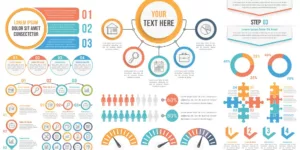Infographics are a powerful asset for businesses and marketing, yet a lot of people have started to shift away from them. There was a time when marketers would make the simplest infographics in an effort to gain links.
Using automation or offering links by hand, these marketers used to post the infographics to directories or sites that feature just infographics.
The problem was quality. Low budgets and expectations that were too high led to these directories and sites being overloaded with infographics that were rehashed or provided little value. And while the automated marketers of the world may have stopped using infographics as a major selling point for their packages, real marketers continued to make infographics when it made sense.
If an infographic doesn’t make sense to add any value, it’s time to ditch the idea completely.
But when warranted, an infographic will be a powerful asset for a business that can be posted on blogs, shared on social media and even used by others in their blog posts. It’s a way to easily digest information, and everyone gravitates towards visuals rather than text.
Why Infographics Are Still a Powerful Medium
Infographics are still being created by some of the world’s biggest brands. DePaolo & Zadeikis created an infographic to go along with a hot topic lately, and the firm knew that this medium would remain a very powerful asset that could be used time and time again.
And it’s easy to see why.
We know that 90% of the information that a person receives is transmitted visually, and the brain can process visuals 60 thousand times faster than text.
In a society where the attention span of a person is shrinking, visuals make sense. Sure, visuals can be regular photographs, but they can also be information-rich infographics. These visuals work extremely well to combine a plethora of information into one easy-to-digest medium.
Additional statistics show that:
- Businesses that use infographics, and we’re talking about rich graphics that are filled with valuable information, can increase their traffic by 12% on average. This is a result of readers viewing the graphic and others, including businesses and bloggers, deciding to link back to the graphic.
- Infographics are able to build brand value, and in the case of the author, it shows that the author is an expert in his or her field. With personal branding, this can have a huge impact on your brand and future business prospects.
- Infographics are engaging, and this is because 70% of our sensory is from the eyes. People want to be able to scan images and digest information faster, and infographics are the perfect, eye-catching medium to do this.
In terms of search engine optimization, you’ll find that infographics are a medium that get a lot of attention from other bloggers and businesses. It takes a lot of time and resources to make a good infographic, and allowing others to use your image with credit does provide SEO value and solid links.
But there is some work that needs to be done on your part, too.
If you just post an infographic on your site, and your site isn’t a popular portal, it will stay there, offering little value to your marketing campaign. You’ll want to post the infographic across all of your social media channels to begin.
Once you’ve promoted the infographic on all of your own social media channels and across all of your other owned channels, it’s time to promote the content using other means. This means:
- Contacting others in your niche about the infographic via social media or email
- Posting the infographic on related infographic websites
- Guest posting on high-quality sites, using your infographic in a post
You’ll want to continue with promotion, posting the infographic often on Facebook and Twitter. You can also use the infographic as inspiration to create other forms of content on your blog and social media.
Let’s assume that you’ll be using statistics heavily in your infographic.
You can tweet out these statistics, use them to create single images or help others that have similar content update their statistics with your new, more accurate data. If you simply create the infographic and wait for results, you’ll be waiting a long time.
But if you create and promote your infographic, you’ll find that the infographic is far from dead.








